BIOS -
BIOS is an acronym that stands for Basic Input/Output System. It is meant to control your product at a very low level. As of right now there are three regularly used BIOS formats (there are actually more than that but there are three common ones). These are the AMI (American Megatrends Incorporated), Award, and Phoenix. The new 3D BIOS version on the Z77 line up feels much smoother than what we saw on the P67 line up and even on the X79 based boards. There were only a few times where we ran into lag while using this BIOS. You can check out the video we shot of the BIOS below.
Overclocking –
We ran into a bit of trouble overclocking the Z77X-UD3H. Normally we can hit 4.8GHz with our Core i7 3770k, but we just were not able to find a stable mix with the UD3H. No matter what combination of settings we tried the board would not pass all of our tests at that clock speed. In the end we did settle for 4.7GHz at 1.35V. This was the sweet spot and as you will see from the scores below it was not that far behind the 4.8GHz clocks we have gotten with other boards.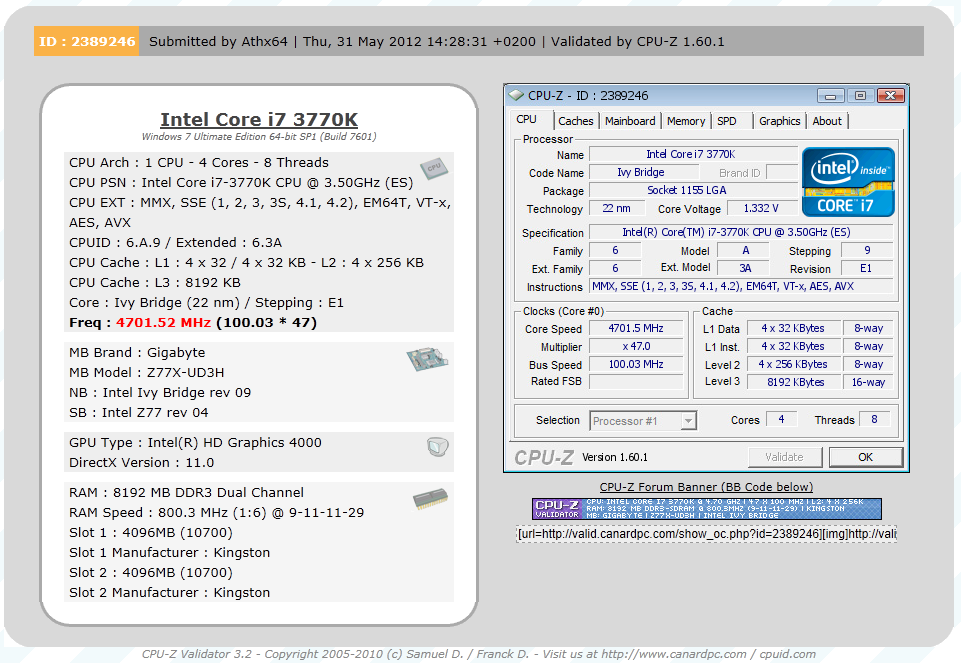
Of course overclocking is a picky subject. I can buy to identical CPUs from the store and they will not always perform the same way under stress. This is the same with motherboards, RAM and GPUs. So again it is important to keep in mind that our results represent a specific hardware configuration. Yours may be similar but will rarely be identical.
Overclocking Tools -
Following along the same lines as our video coverage of the new graphical BIOSes on most motherboards we are starting to cover the overclocking tools and add-in utilities using video as well. This is a much better format and allows more information to be delivered about what the software can do. With the Gigabyte Z77X-UD3H the tools in question are EasyTune 6 and their 3D Power application. Both are good apps although we did have some issues with EasyTune 6 and our 3770k.
The Test System and Comments -
Our test system is built on an open bench. This has two effects on testing. First it allows us to see everything and also to setup and disassemble the test rigs quickly. Second it means that we cannot gauge the potential air flow found in a normal case. The air is pretty stagnant; some may say this is a great neutral testing method and it can be. However, it does mean that the temperature reading taken off of the components are not accurate to what an average consumer would see. This means that your thermal performance will vary from what we see here. As with most modern motherboards the Z77X-UD3H was simple to get set up and running. The installation of Windows 7 x64 Ultimate was fast and went by without any issues. We did have some problems getting all of the utilities to install especially the Intel Rapid Start and Smart Connect features. It took a few tries to get them operational even using the EZ Setup for those features. We did finally get them running, but to tell the truth we did not see any improvement from Rapid Start and we were not able to run Smart Connect long enough to see anything happen with it. 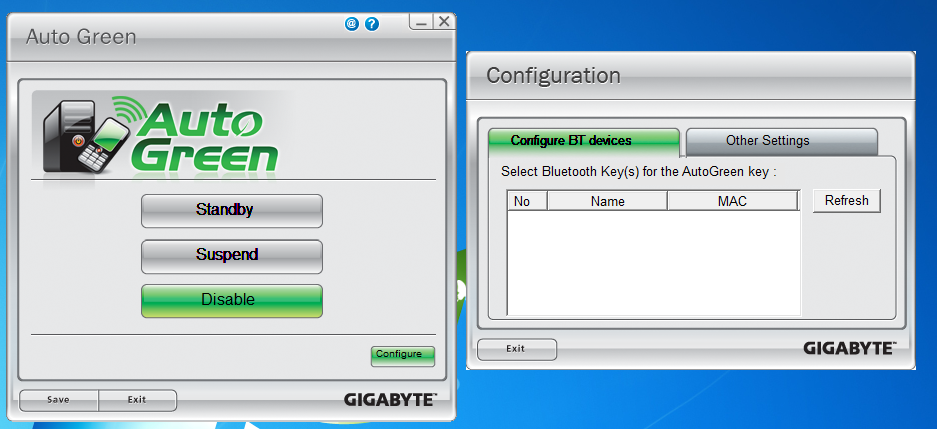
The mSATA port was also put to the test. This is a nice feature that Gigabyte has thrown in, but it has limited usability in this market. Buying an mSATA SSD will run you around $200 (depending on capacity), but as the port is only SATA II it is not going to be as fast as picking up a SATA III 2.5-inch SSD and just using that. Even a 240GB SATA II SSD would be a bigger benefit than using the mSATA port at this time. Sure you could use it as a caching module, but it is not going to get you that much of a performance boost so for right now, it is not worth the cost to utilize this feature. Fortunately Gigabyte’s inclusion of this port did no0t add much to the retail cost of the board so you are not losing anything there.
Performance testing overview -
Our testing is a little different than most. We combine both synthetic and real-world applications to simulate the types of performance common to the individual products. For motherboards this means that we run roughly six synthetic tests and two real-world. We will be expanding the real-world testing in the near future. But there is more to performance than just the raw numbers. As there are multiple components and sub-components on a motherboard there each item can have a distinct impact on the way the product will perform once you get it in your system. It is important to note not only the actual results but what they mean to you as a potential consumer. We will try to give this information to you.
But we do not just cover the performance aspects that are measurable. We also talk about the components that might not have a direct benchmark. These are items like Audio Quality, ease of use and installation.
Section 1 Subsystems
Memory -
Memory performance is very important on a motherboard, especially when you have a CPU with multiple cores and threads. If you have slow memory your cores and threads can become starved for data to execute. To test memory performance we run both Sisoft’s SANDRA and AIDA64. These two combine to not only give us accurate numbers but to validate each other. For testing at stock speeds the memory is hard set to 1333MHz while overclocking testing is done at the highest stable speed for the voltage of 1.65v this is due to the different memory dividers for each CPU. As such, the memory speeds will vary greatly. This means that the overclocked numbers are a little misleading and while they can show a trend are really only included to show if a board has a problem with memory performance at high clockspeeds.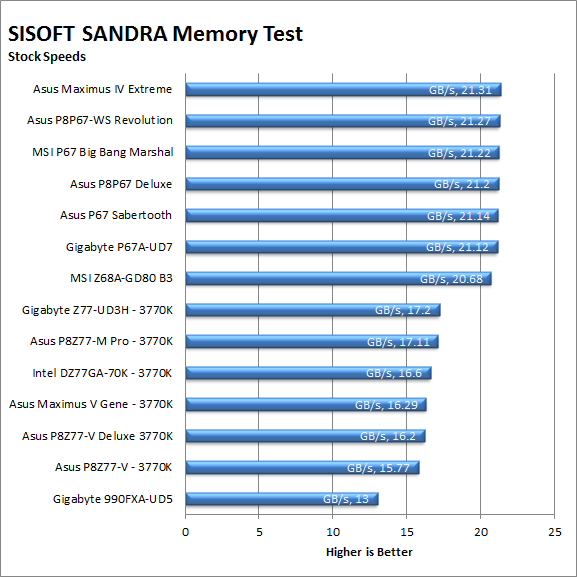
The Gigabyte Z77X-UD3H was at the top of the Z77 list for memory performance (even if only by a small margin). This could be a good indicator that we will see solid performance from our memory dependent tests like HyperPi, PCMark07 and 3D Rendering. It is also good for those that like to multi-task with better memory performance you can usually have more programs open without seeing the system bog down. Of course the amount of memory will be a big part of that as well.

Drive performance -
Drive performance is also one of the major subsystems that goes to make up the performance of a motherboard. For our testing we use Sandra and AIDA64 again. We only test with single drives for each type of controller present on the motherboard (unless it is a professional product where we will use RIAD 5 and/or 10). We have also begun using a Seagate PS-110 USB 3 external HDD and a Kingston HyperX USB 3.0 Flash drive for our USB 3.0 performance. As a side note, we include the overclocked numbers here to make sure (again) that you are not going to see a major drop in performance due to minor instabilities at high clock speeds.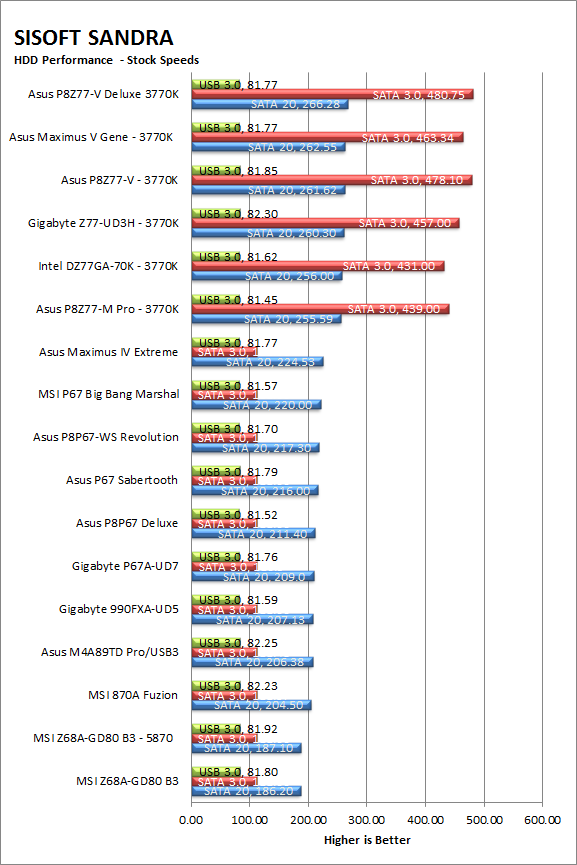
For SSD performance the Z77X-UD3H right behind Asus’ P8Z77 – V for both SATA 2.0 and SATA 3.0. This is a good showing and one that when combined with the solid memory performance should give you good results in almost any type of task you want to put the UD3H to. We are expecting to see some good numbers in the rest of our testing.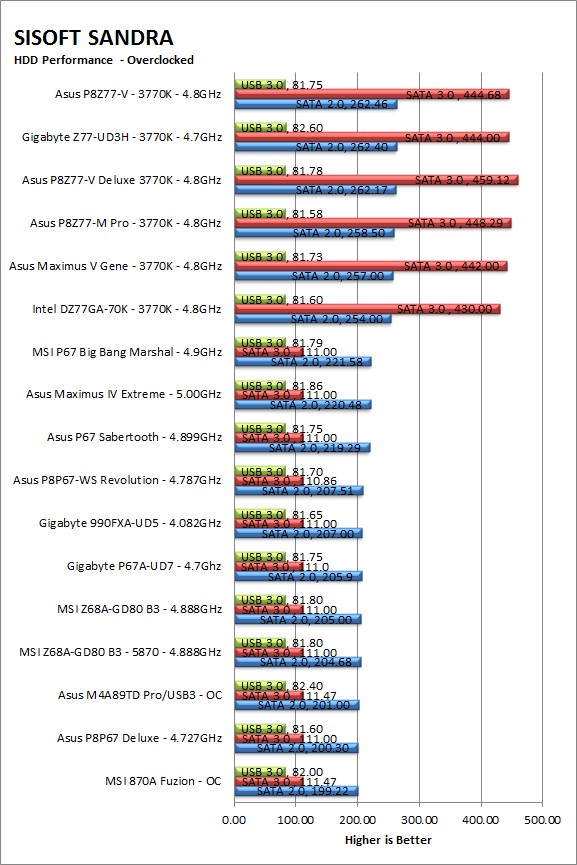
Power -
Power efficiency is another of those misnomers that we get caught up in. We hear about idle states and power gates. But what does that mean to you and I? On the surface having power management that reduces idle power sounds great and can be a benefit to someone that leaves their system on for long periods of time (and inactive) but how a system handles power under load and the delta between the two states is often more important than the idle power usage numbers. We use only P3 Kill A Watt instruments for measuring power.
| Power iGPU Stock | Power iGPU Overclocked |
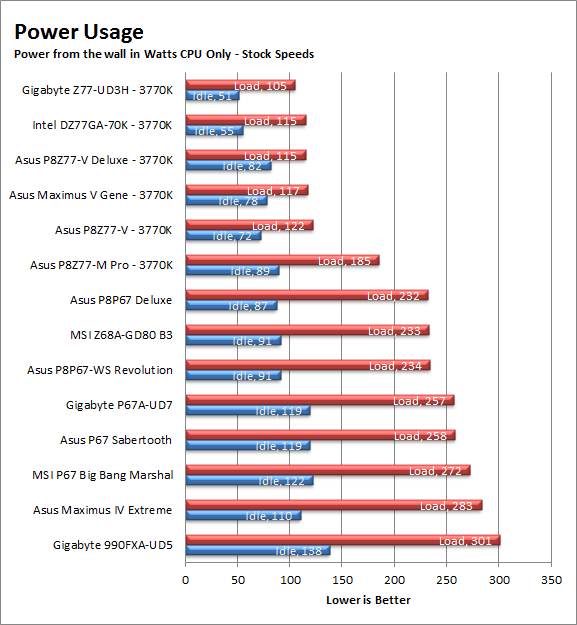 |
 |
The Z77X-UD3H is very power efficient when it is just dealing with the Core i7 3770K. Even overclocked we found it to be very efficient. Once we put in the HD5870 the system pulled quite a bit more power. This was not unexpected, but we would have thought that we would have seen less of a power demand considering how efficient the Z77X-UD3H was with only the CPU and its GPU.
| Power With Add-in GPU Stock | Power With Add-in GPU Overclocked |
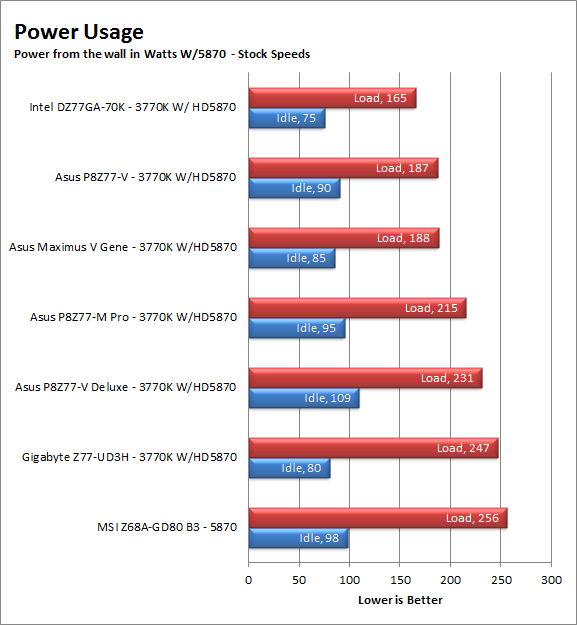 |
 |
Cooling (Board Level) -
Board level cooling is an important factor in product performance and longevity. Components like the chipset, VRM modules and even capacitors need to be kept relatively cool to prevent failure. As these parts are made of silicon, they have a thermal breakdown threshold; or melting point. At that temperature the actual transistors built into chip will begin to deform and break down. Granted, the threshold is often very high, but you still need to make sure that components stay away from this level of heat for longer product life.
| PCH Heat iGPU Stock | PCH Heat iGPU Overclocked |
 |
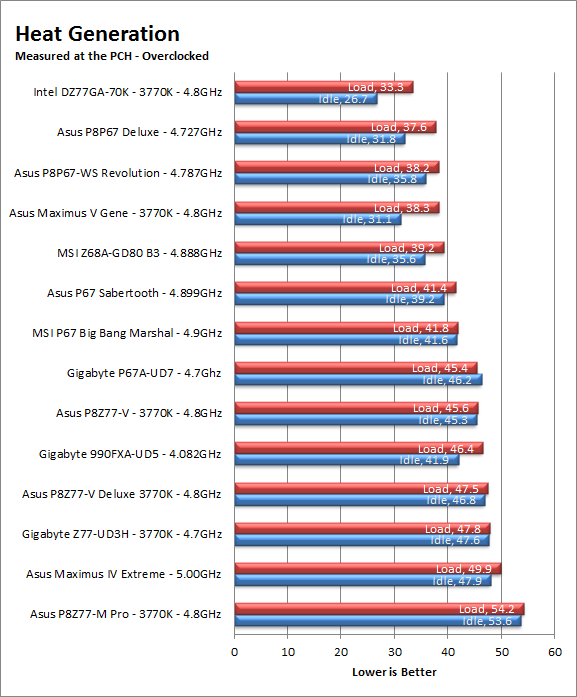 |
The cooling on the Z77X-UD3H was not as efficient as we would have liked. Granted the board is not in a case where there is the potential for continuous airflow over the heatsinks, but still we would have liked to see it perform better. The good news is that even overclocked there is not a huge difference between idle and load temperatures. This means that you do not have to worry that much about damaging the PCH by overclocking. You should still keep air flow and cooling in mind, but it does not look like you will have that much of a risk of killing it unless you try and pump a ton of voltage through it.
| PCH Heat With Add-In GPU Stock | PCH Heat With Add-In GPU Overclocked |
 |
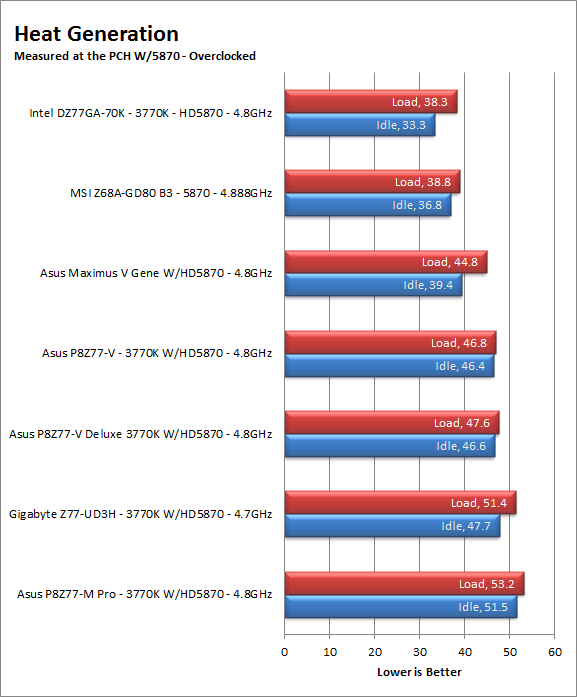 |
Audio -
Audio is highly subjective. What we find pleasing may sound “off” to you. That is always going to the problem with testing audio; results will vary too widely depending on the tastes of the listener. However, there are ways of measuring the audio output with an objective ear. There is also the issue of audio causing performance issues in gaming and video playback. The reason this is a potential source of concern is that all onboard audio CODECs (Compression/Decompression) are CPU controlled. This means that while the audio chip controls the audio levels and effects of the audio the actual work is done on the CPU. Usually this will not be a problem with today’s powerful CPUs. Even the lower and consumer level products can handle high-end audio these days. But again there is the chance that a bad design or software will hinder your system and performance. On the other side the limits of board space, cost, etc will also prevent the level of audio quality you can get from an add-in board. We test all audio parts with three media types, Movie (DVD), MP3 Music, and Gaming. These are pushed to our Tec On model 55 Tube Amp to see if we can detect any signal issues in the reproduction.
The audio on the Z77X-UD3H is good; not great, but still good enough for most tasks. Audio is one place that Gigabyte has always tried to work on even back in the days when they were not doing so well in raw performance. However, there really is not that much you can do with an onboard CODEC. Gigabyte has (on their higher level boards) built entire audio cards into the product, but for the most part you are getting signal processor that still relies on the CPU to perform the software based audio compression and decompression. We found that for many audio samples there was a tendency to have cluttered mid-range sounds with light bass (meaning that the mids and lows are not separating properly). Fortunately there is not much brass in the high-end so what you end up with is decent sound that feels like it lacks punch.
Networking -
This one is something that is a requirement anymore. If you have a computer, the chances are good (like 99%) that you are also connected to high-speed internet. With this you need a good and solid LAN chip to make sure that your data flows properly out and back. The networking performance was also very solid with no noticeable lag or issues noted in gaming, file transfer, media streaming or anything else.
Section II - Performance Tests, Synthetic
In this section of testing we cover the synthetics. These are tests that run a scripted sequence of internal APIs or that use another installed application to perform a series of scripted events. They are great in that they can provide reproducible results across various platforms. On the down side, synthetic tests can be fooled with driver tweaks and optimizations. In some cases it is necessary to rename the .exe file to something generic to discover if this is the case. In any event when this is needed (when a test shows a drastic difference in performance over the renamed exe) we will note this and show both results for comparison.
PCMark7 -
PCMark7 is the latest general performance test from FutureMark. As each generation of this benchmark has evolved and developed we have watched them add more and more realistic tests to this suite. With this generation we find more media tests, (audio and video transcoding) moving of large files, multiple web page rendering, and much more (the even added DX10 gaming). We use the Overall Performance and Common Usage suites in our testing.
| PCMark07 iGPU Stock | PCMark07 iGPU Overclocked |
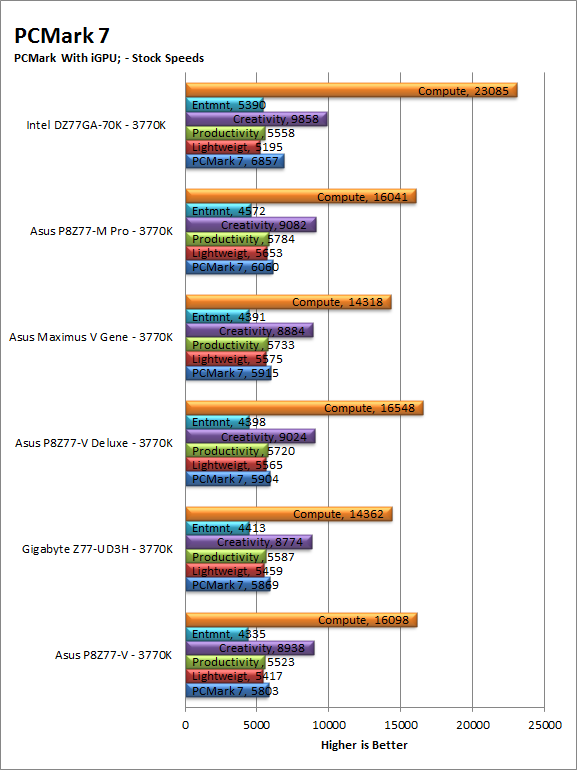 |
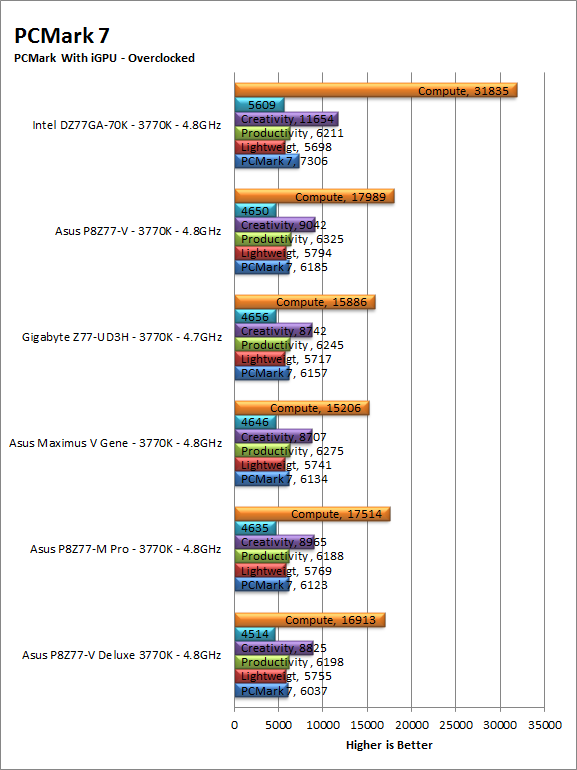 |
For general computing tasks the Z77X-UD3H falls into the middle of our group. This is with the iGPU and the HD5870. We were a little surprised here as we expected it to perform better with the memory and HDD performance that we saw. Still the numbers are very close here(with the exception of the Intel DZ77GA-70K) so we sure that it will still do the job for you.
| PCMark07 With Add-in GPU Stock | PCMark07 With Add-in GPU Overclocked |
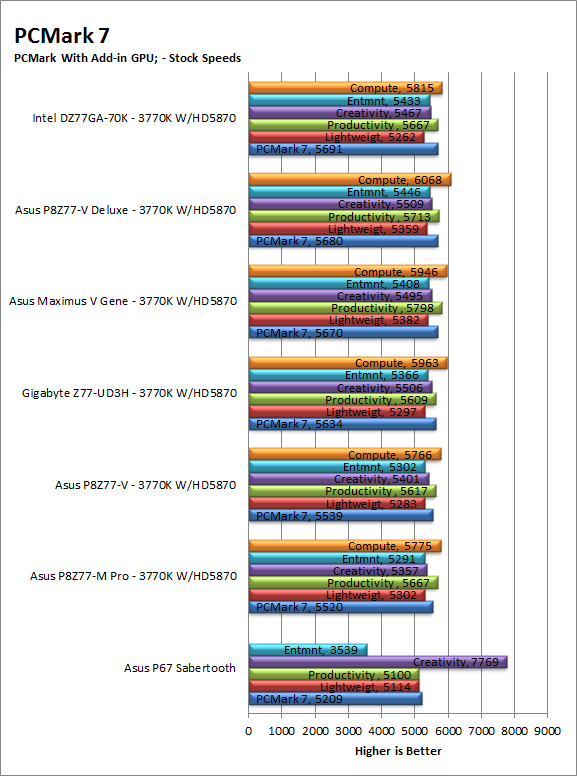 |
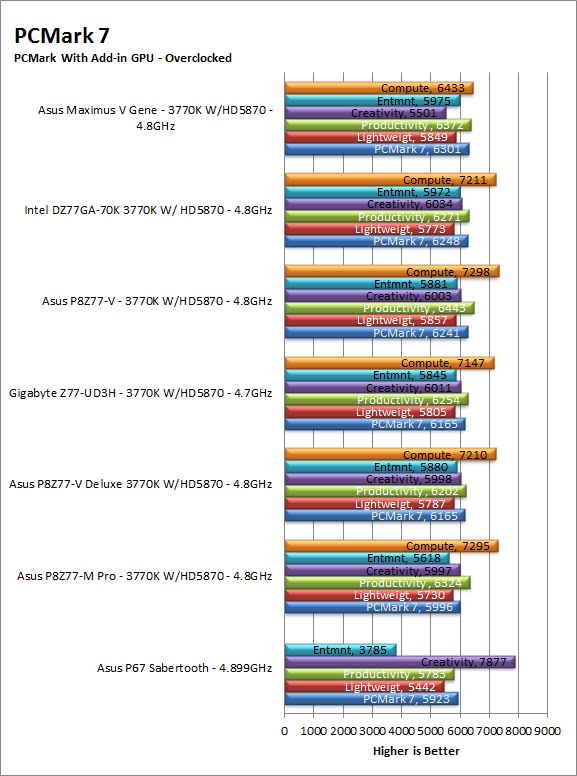 |
3DMark 11 -
3DMark 11 is the other Futuremark test that we run on our motherboards. This test simulates the typical tasks that a GPU (and system) would have to perform to provide you with a good gaming experience. It is based on the DX9, DX10 and DX11 engines but can only be installed on Windows Vista or later. The suite of tests covers DX9, DX10, and of course DX11 rendering; it also covers AI computations and physics. That’s right I said Physics the latest version of 3DMark uses a Havok physics engine. This removes the advantage that nVidia had with 3DMark Vantage.
| 3DMark11 iGPU Stock | 3DMark11 iGPU Overclocked |
 |
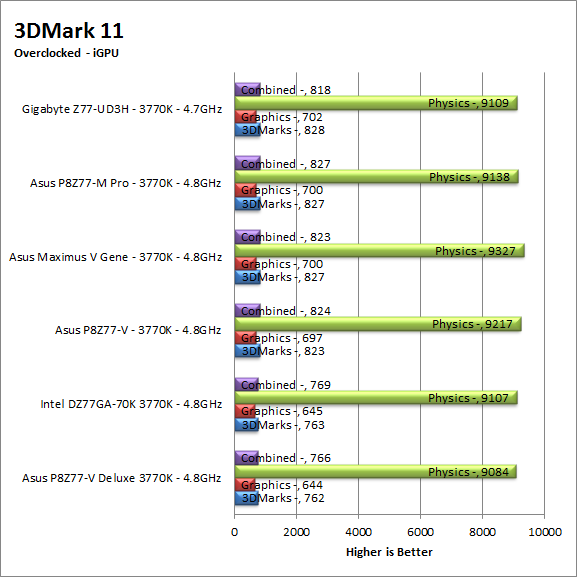 |
Oddly enough we found that the Z77X-UD3H did not do as well as other Z77 boards in 3DMark11 when we dropped the HD 5807 in. This was under both stock and overclocked speeds. This was surprising considering how well it performed with just the GMA 4000 running the show. It is possible there is something going on with the way the system auto detects the generation of the GPU. We saw something like this before on another board and could be seeing it again. Still this is a synthetic test and while it tells a portion of the story it is not all of it. We will have to see how the Z77X-UD3H does when we put it through our real world gaming.
| 3DMark11 With Add-In GPU Stock | 3DMark11 With Add-In GPU Overclocked |
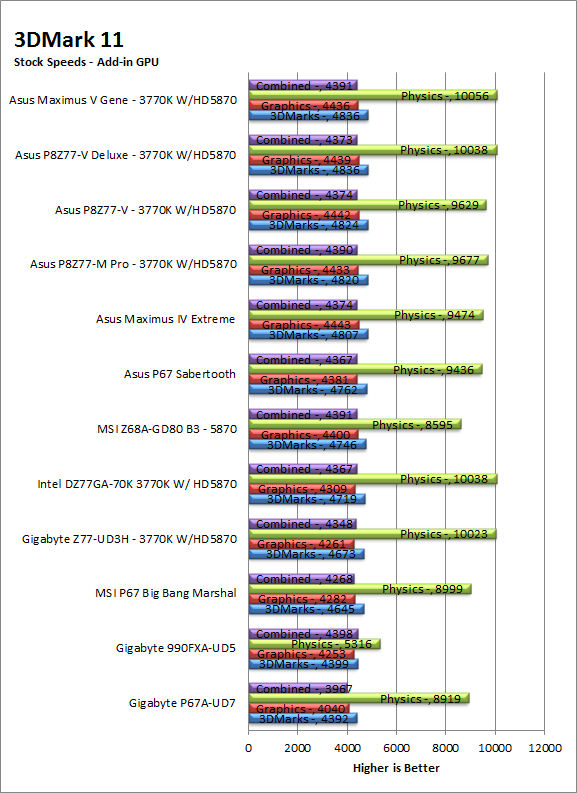 |
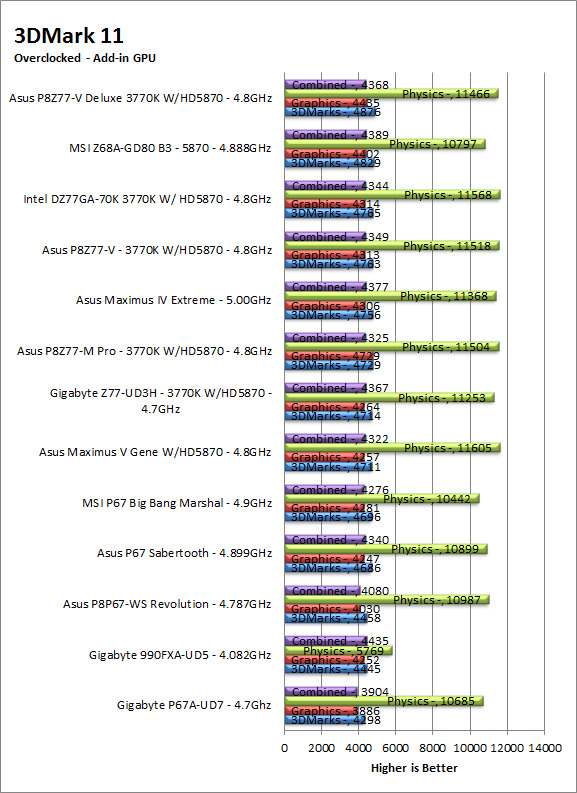 |
HyperPi 0.99b -
HyperPi is a front end application that allows you to easily run multiple instances of the SuperPi application. SuperPi, for those that are not familiar with it, is an application that measures the time it takes to calculate the number Pi out to as many as 32 million places. This calculation is then checked and run multiple times (up to 24 for a 32M run). This test stresses the CPU, Memory and HDD as data is handed off between the three. If there is a weak link, HyperPi will show it. For our testing we run the 32M test on as many cores (and threads) as the CPU has available. The slowest CPU time is then recorded. 
The Gigabyte Z77X-UD3H did ok in our HyperPi testing. It was about 18 seconds behind the two leaders at stock speeds. This is not all that bad and still shows that it can perform well under full load. When we ran the same test at 4.7GHz the times dropped off. If this is not an issue with the way HyperPi loads up the calculations then we might see this performance reflected in our rendering tests later.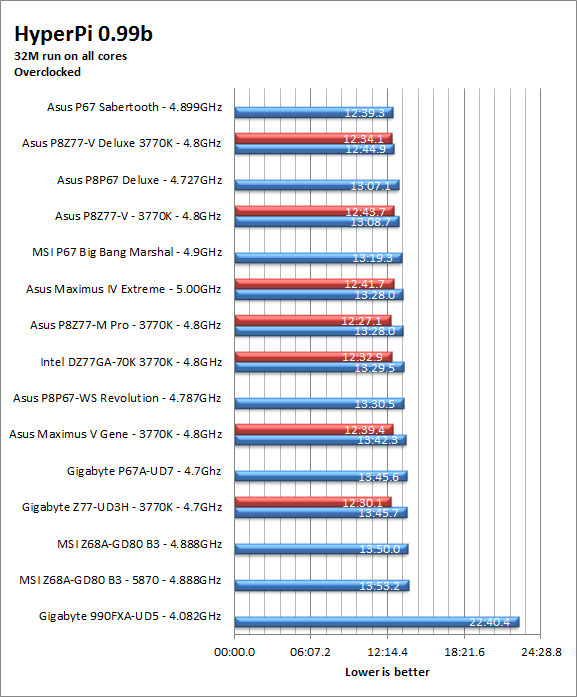
Cinebench R11.5 -
Cinebench R11.5 is the 11th release of Maxon’s rendering test. This test is based off of the Cinema 4D engine, which is one of the industry standard tools for digital animation. It is a powerful product with many different modules that can be “plugged” into it to increase its effectiveness. With Cinebench you get to see how your computer would do using this application. There are two tests; one tests the CPU’s ability to render an image across multiple cores or threads. The other tests your systems ability to handle OpenGL based rendering.
| Cinebench R11.5 CPU Render Stock | Cinebench R11.5 CPU Render Overclocked |
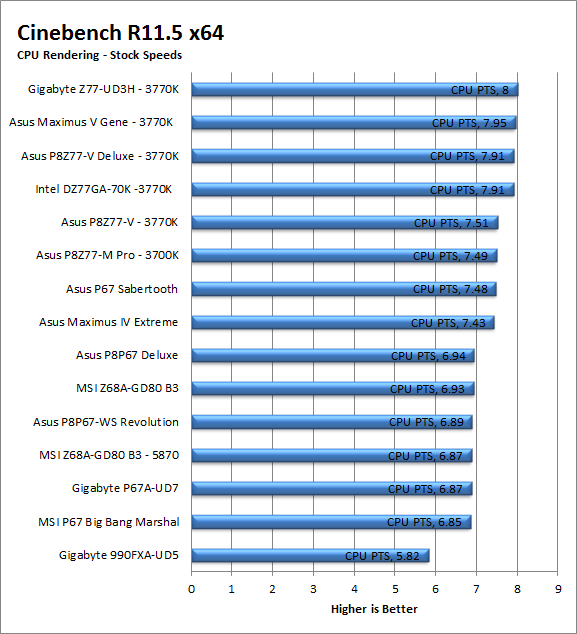 |
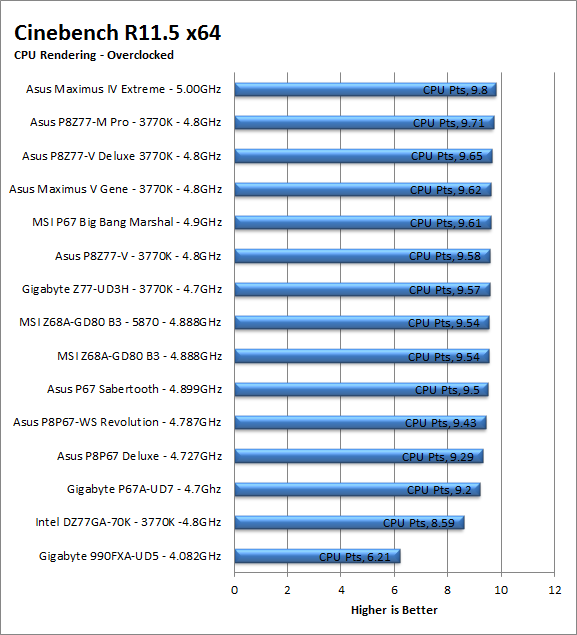 |
At stock speeds the Z77X-UD3H does very well running the Cinebench R11.5 CPU render test. We see it out on front by .05 (which is actually a lot). Overclocked it falls pretty far behind which is surprising, but again could be due to the way the board is handling moving data back and forth between the memory and CPU under load.
| Cinebench R11.5 OpenGL Render Stock | Cinebench R11.5 OpenGL Render Overclocked |
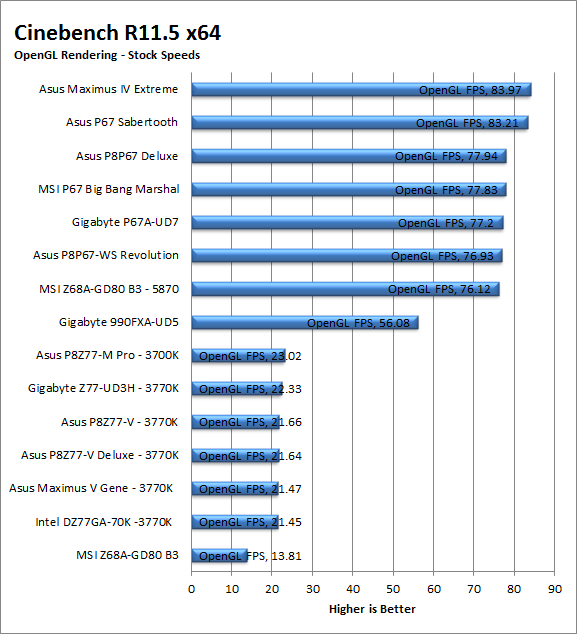 |
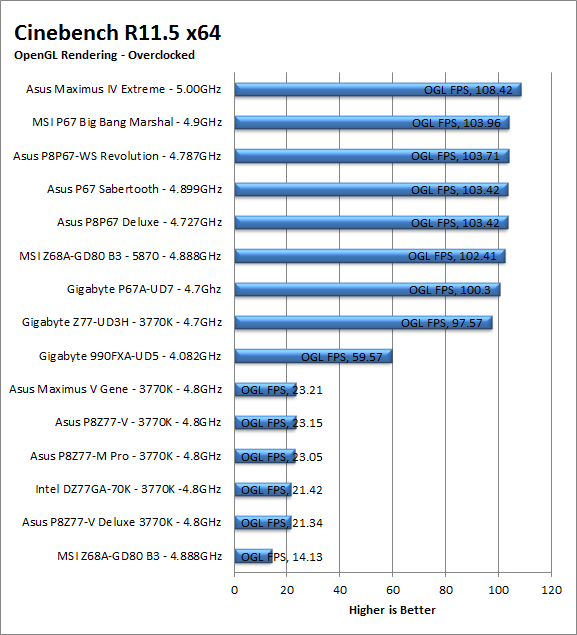 |
Section III - Performance Tests, Real-World
Here we have two tests that are designed to put the performance of the motherboard and its subsystems to the test. Both require good CPU, Memory, HDD and even to a lesser extent audio and network performance. The two tests we chose were Lightwave 3D 9.6 and Cyberlink's Media Espresso 6.5. We will be adding at least one more real-world test to this battery in the near future, but for now these two cover quite a bit.
Lightwave 3D 9.6 x64 -
Lightwave is another industry standard application for 3D animation and rendering. It has a large tool base and the rendering engine is highly threaded (when using the right render model). This application is also capable of expanding to 4k resolutions as well as ray tracing for rending the light sources. For our testing we use frame 470 of the Pinball scene found in the LW 9 Content folder. This uses the newer perspective camera that is better suited to a multi-CPU/Core environment. This camera style also uses ray tracing and a much improved anti-aliasing method. Settings are shown below in the attached screen shot. Of course these are single frame renders and they are not a complete picture; for that you have to take into account the number of frames an average project would have. In a typical 30 second commercial you will have around 840 to 960 frames (at 28 – 32 FPS) this means that you have to multiply the time of a single frame by that number just to get a vague idea of how long that 30 seconds would take. This is because each frame will have a different render time based on complexity.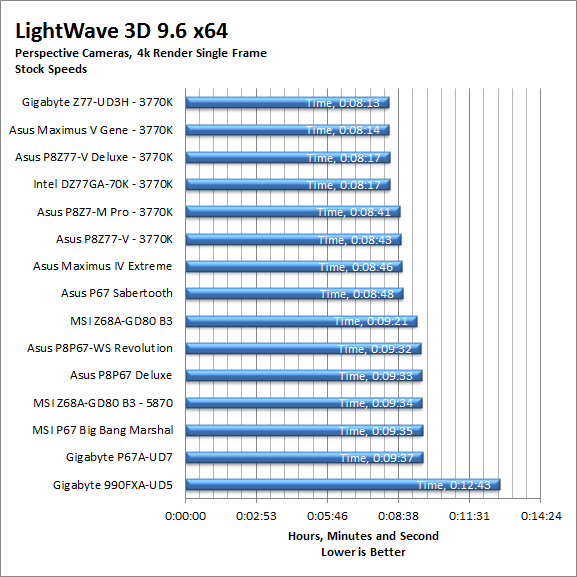
We see a similar story in our LightWave testing. At stock speeds it is on top, overclocked it drops behind. The drop here is also more than we would expect from a 100MHz difference in clock speed so we have a feeling there is something going on that is causing the board to have problems when it tries to process that much data at high clock speeds. This could be an issue with the way the board handles memory, the CPU or something else. Still as it is a board issue (these are all the same components we use in all of the Z77 tests we have done) it is very likely that Gigabyte can fix this with a BIOS update.
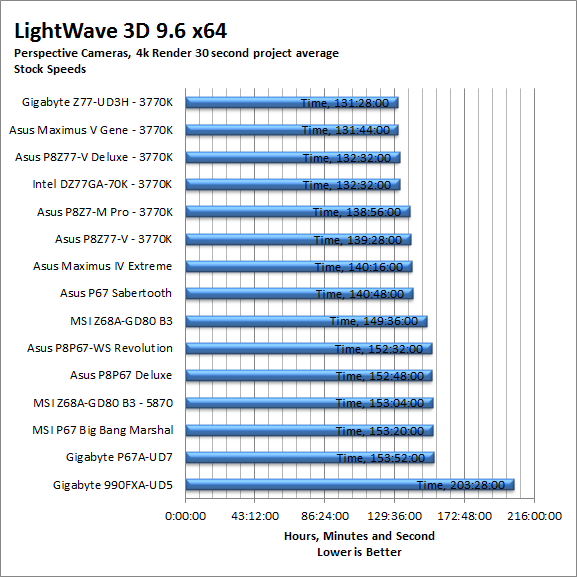
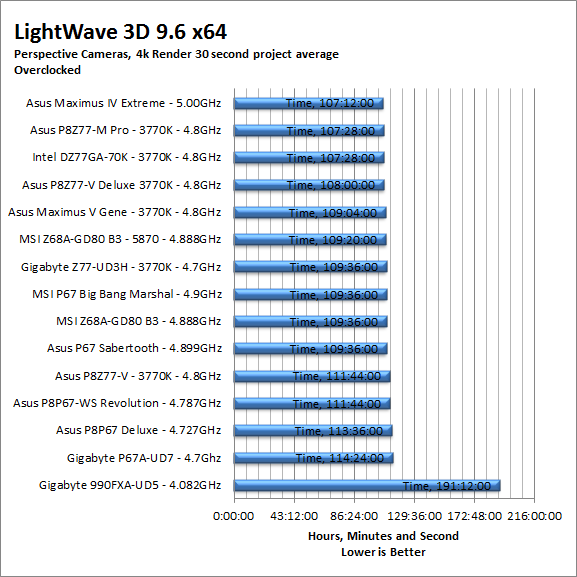
CyberLink Media Espresso 6.5 -
After having various issues with AutoGK and Intel CPUs with more than four cores we have changed our Media Encoding test to use Media Espresso from CyberLink. Although this new utility does not have the same ability to transfer directly from DVD it is still a good test to transfer different media types into a usable format for your iPad, iPod, or other media player. Our test involves using multiple (Six) 20 minute media files and transcoding them for an iPad. This gives us a very good indication of how well a motherboard can handle this type of work load.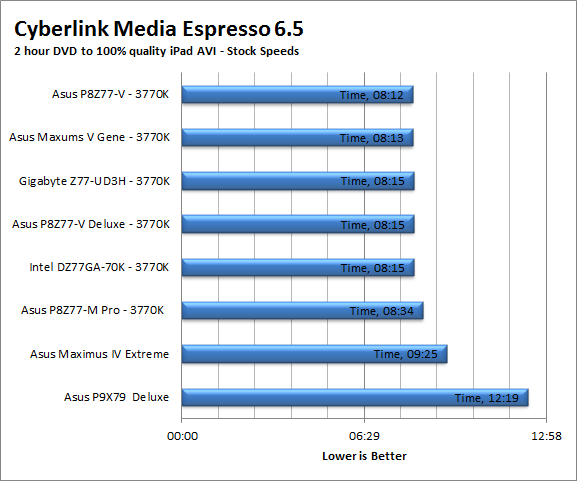
The transcoding performance of the Z77X-UD3H is where we would expect it to be considering its market position. Of course, to be perfectly honest we would expect any Z77 board with an Ivy Bridge CPU to do well in transcoding. That is what Intel intended when they were designing it.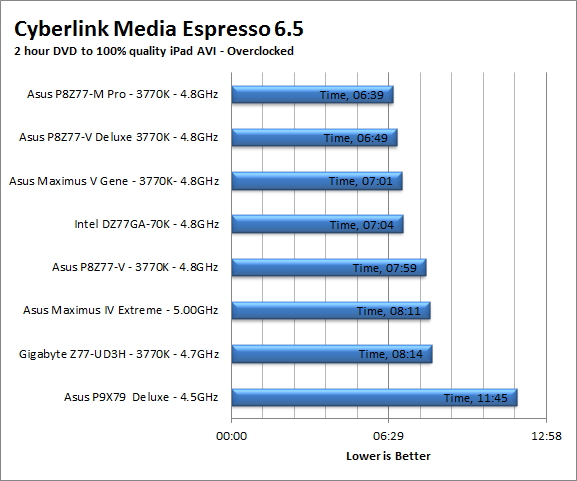
Section IV Performance – Gaming
Gaming as a test of motherboard performance is sort of a joke these days. The big player in the gaming arena is the GPU. Everyone but a few hardcore PR teams know this. However, it is important to run at least a few (one from each current DX version) to see if there are any issues with the combination of components on a motherboard. These are items like Audio lag, memory lag and of course problems with the PCIe lanes and signal traces. If there are issues in design, drivers or BIOS then you can have odd gaming performance. So without much more preamble let’s dive into the three games we currently use; Call of Duty Modern Warfare 2 for DX9 FarCry 2 for DX10 and Battlefield Bad Company 2 for DX11.
Call of Duty Modern Warfare 3 DX9 -
As the third installment in the Modern Warfare franchise you are picking up some old roles while adding a couple of new ones as well. The game play is almost identical to what you are used to in Modern Warfare 2 as are the graphical settings. The AI is a little different thought it is still similar to the bar fight style AI we like in the Call of Duty series. For our testing we run the first mission (Black Tuesday) from start to finish. Settings are shown below
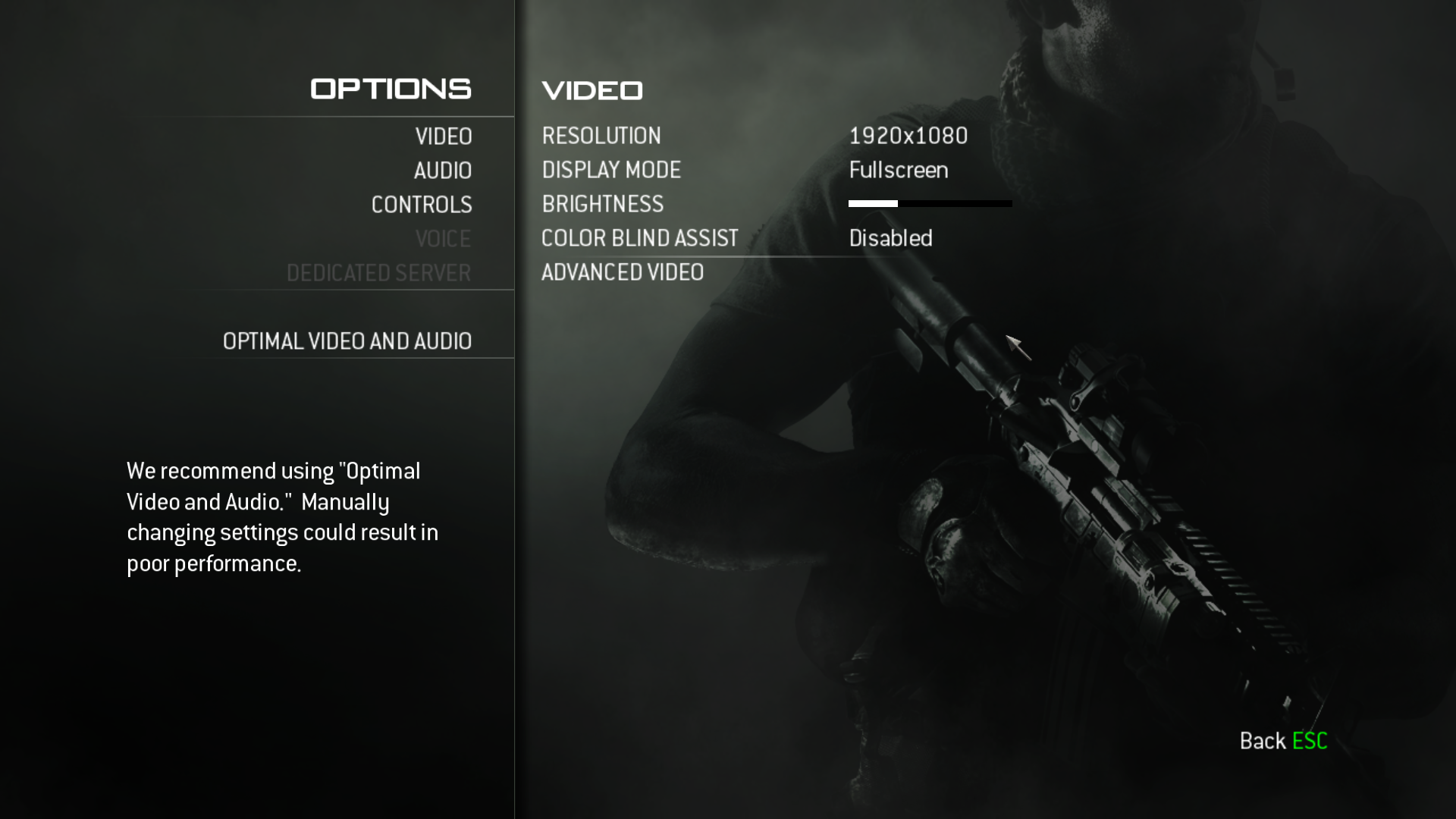 |
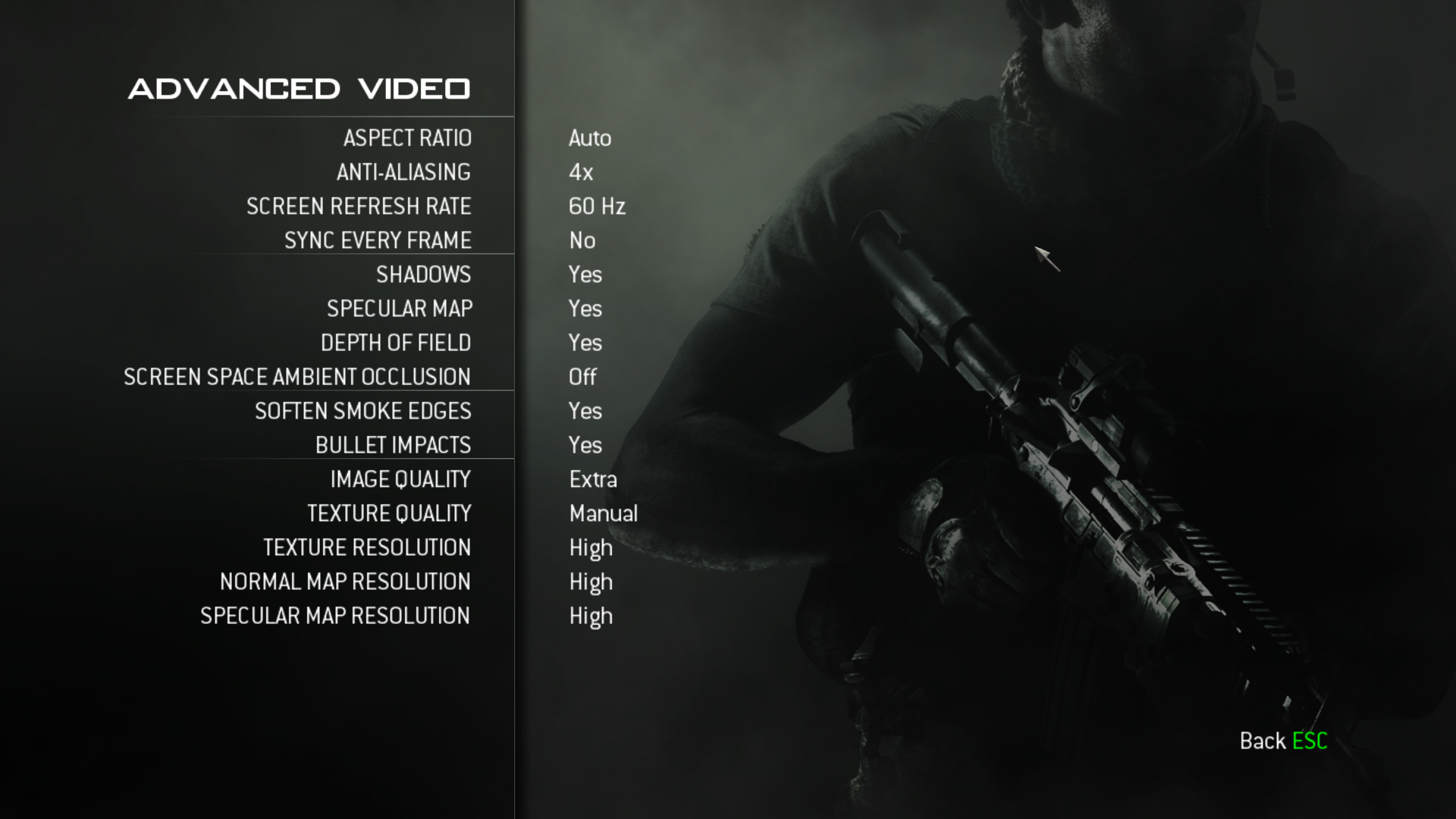 |

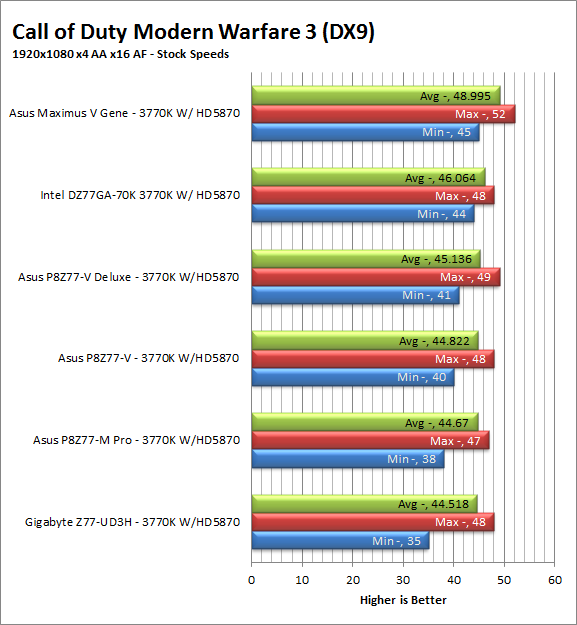
As we have found Modern Warfare 3 is not that demanding of a game with its DX9 engine. The UD3H is able to do quite well with this game (which could be a good thing for many people). When there is an add-in GPU thrown into the mix things get even better.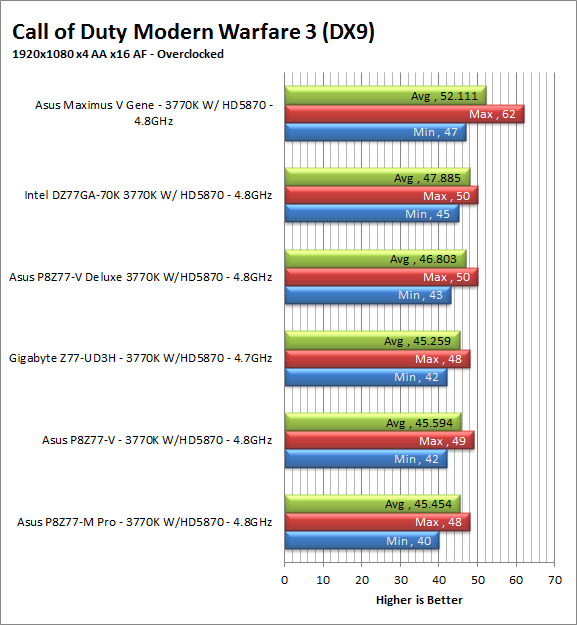
FarCry2 DX10 -
Although not one of my favorite games this tedious game does have some good graphics. The large sandbox style of the game lends to mission based play. The only problem is that the AI is rather low grade. Still the more CPU power the more the bad guys try to do. Over all the game was a little bit of a disappointment to play, but still not a bad DX10 representation. Our testing run starts right after you get your first mission to clean out the safe-house and ends after the hostage rescue. Settings and performance numbers are shown below.
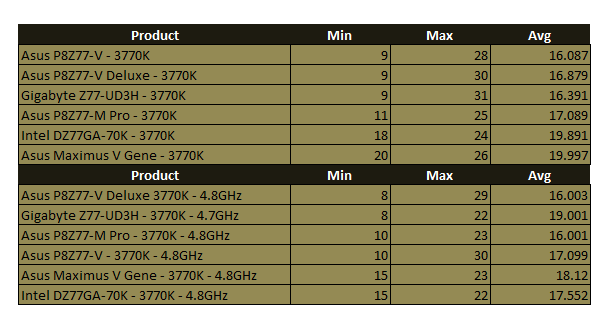
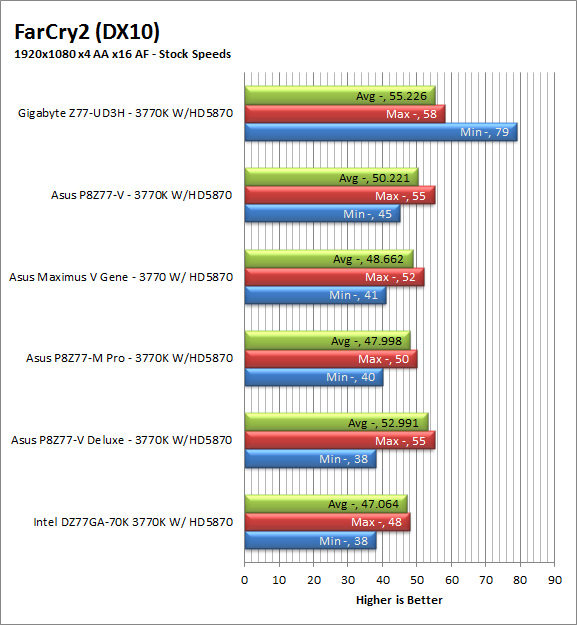
There is really not much to say here. The iGPU is not meant for hardcore gaming and the DX10 engine used in FaryCry 2 is simply too much for the Z77X-UD3H when that is all you have to drive the display. When you have a real GPU in the system things turn around and the gaming performance is much better.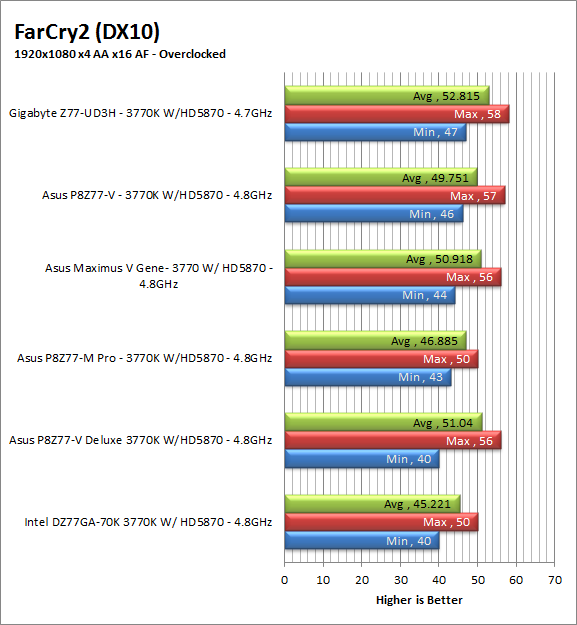
Crysis 2 DX11 –
Another sequel Crysis 2 follows up on two other Crysis games (making the title a little misleading). You take the role of a Force Recon Marine who is given a battle suit by a character named Profit (you will remember him from the other two Crysis games). From there you run around an Infected and Invaded New York City trying to survive and, of course, save the planet. For our testing we ran through the first “mission”. Settings are shown below.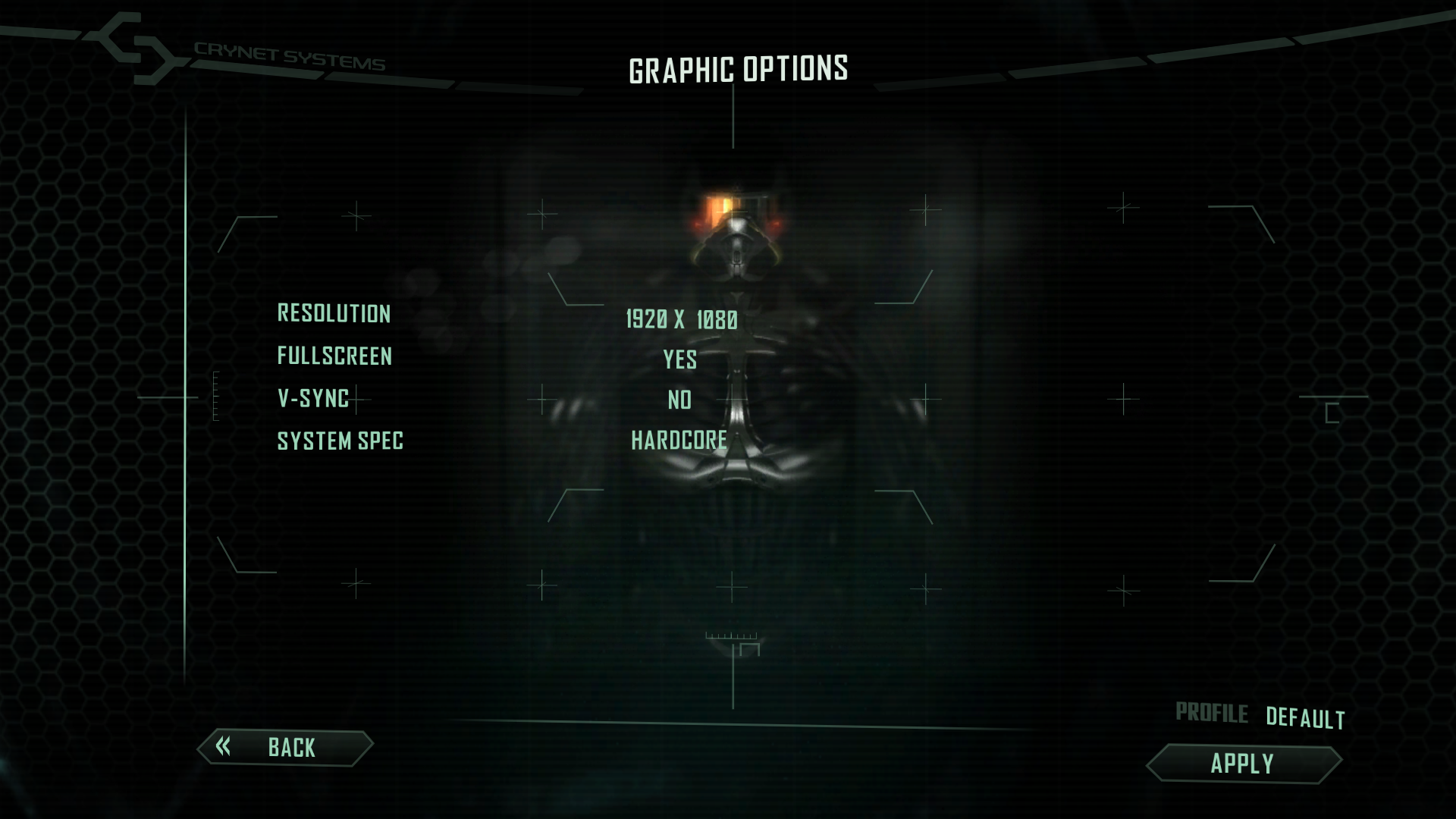

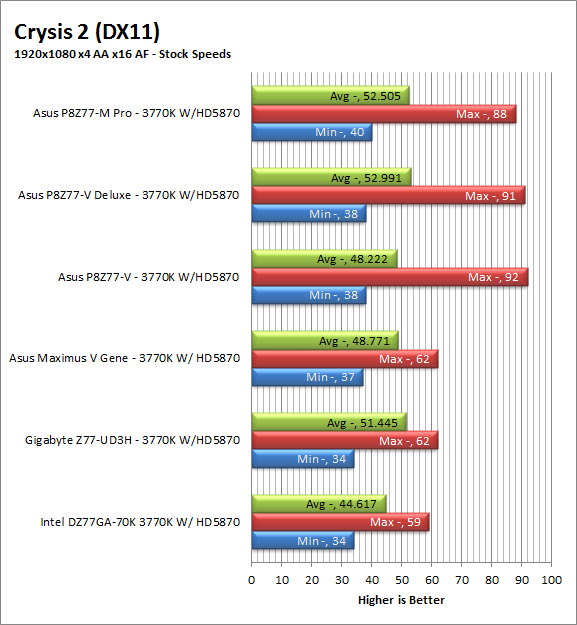
In our time playing Crysis 2 we found that the UD3H does very well playing this game while overclocked. It is not all that great at stock speeds though. Granted all of the boards we tested would work well for gaming… as long as you have the right combination of parts in the system.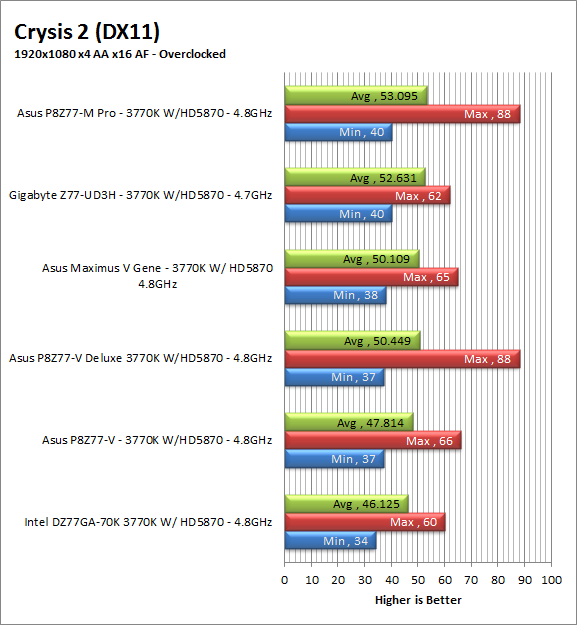
Gaming wrap-up -
Overall the gaming performance on the Gigabyte Z77X-UD3H is what we would expect from a motherboard it its price range. You are going to get solid performance as long as you have the proper components in the system. Of course you can do some mainstream gaming if you want to use the iGPU that comes in either a Sandy Bridge or Ivy Bridge based CPU, but you are not going to be able to play the more modern (and demanding) games. The audio was solid, but again not award winning, but it will do for many games.
Value -
Value is another very subjective topic. What is expensive to some might be a deal to others. You can look at this topic in multiple ways. One is raw price and the other is what you get for the money. Each is accurate and both are correct ways to look at price/value. We tend to look at features, performance and real-property when we discuss value. However, we also take into account the raw cash cost of the item. At $150 the Gigabyte Z77X-UD3H is quite a board. Sure it does not have wireless or dual LAN, but it has some very solid performance for a $150 Z77 motherboard. You are still getting SLI, Crossfire, ultiple USB 3.0 ports, SATA 3.0 and an mSATA slot to keep you happy.
Conclusion -
As we said the Z77X-UD3H is a great board for the money. It would make an excellent low-cost gaming platform with either an Ivy Bridge or Sandy Bridge CPU. With its good memory and HDD sped you should have no problem getting all of your games loaded up while the option for SLI and Crossfire will keep your frame rates high. With the option for an mSATA card this board could also double as a nice HTPC with a lower powered CPU and inexpensive GPU (the Intel iGPU is ok, but only in the higher end CPUs). You could drop in a 80GB mSATA card for your OS and applications and a pair of 2TB drives for recoding and storage of your video files. At this point you have not spent a lot, but have a great basis for a home entertainment PC. We did not have the best of luck overclocking the board, but we also know that mush of what we saw happening can be corrected with a few BIOS tweaks. Really no matter how you slice it the Gigabyte Z77X-UD3H is a solid board with a low price tag.
With its blend of price and performance the Gigabyte Z77X-UD3H has earned our Silver Key Award;
Discuss this in our Forum

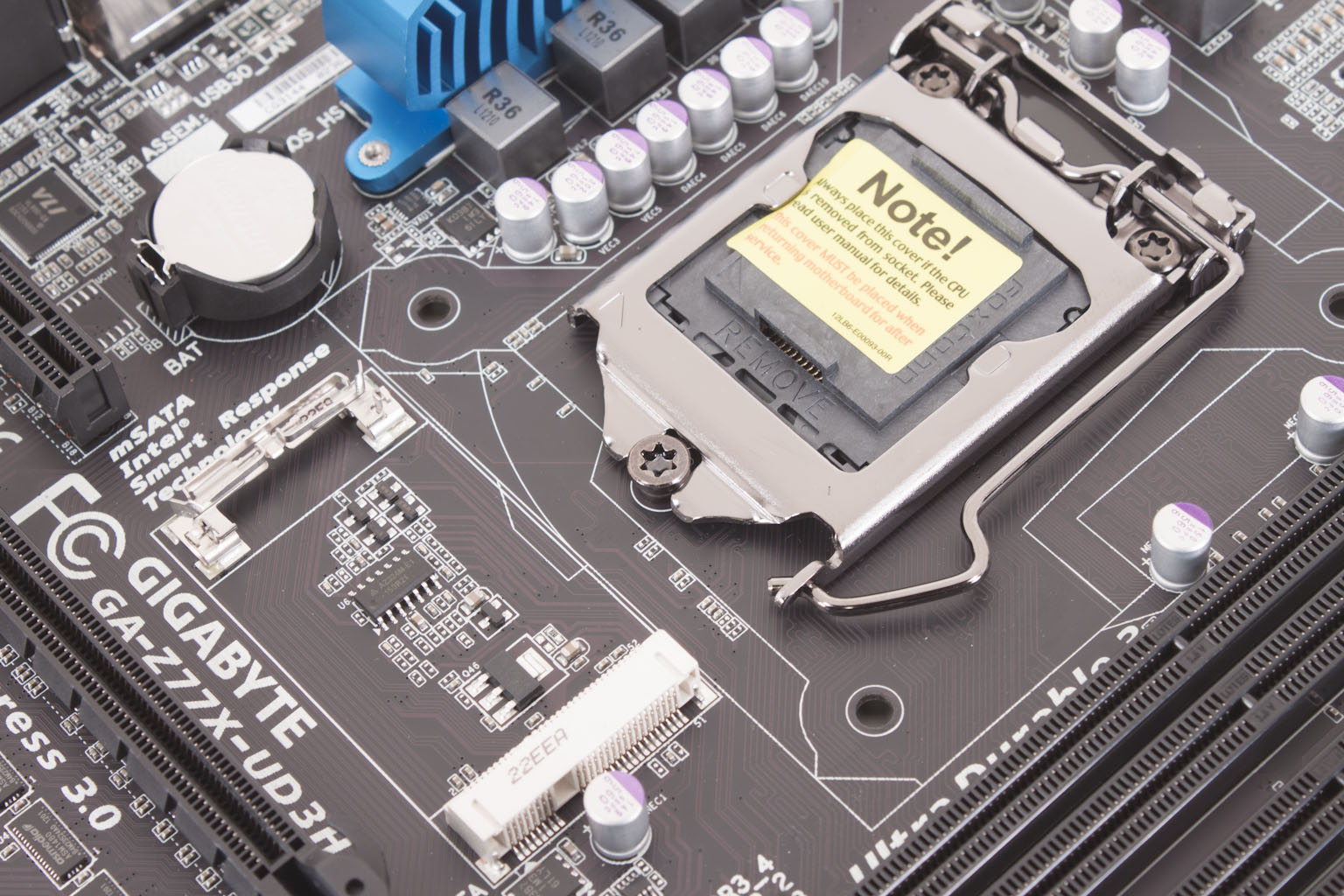 After spending some time working with the Gigabyte Z77X-UD3H and all of the features that are packed into this board we are ready to cover the performance and user experience side of this motherboard. For those of you that might have missed it you can catch our
After spending some time working with the Gigabyte Z77X-UD3H and all of the features that are packed into this board we are ready to cover the performance and user experience side of this motherboard. For those of you that might have missed it you can catch our 

